None
Most users ever online was 387 on Tue Dec 05, 2023 7:35 pm
The newest registered user is Skylines3
Our users have posted a total of 47490 messages in 4938 subjects
| No user |
• The FREE hand reading services at the Modern Hand Reading Forum are being continued in 2019 with the assistance of Google adsense!
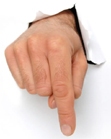
Learn how to read hands according the Modern Hand Reading paradigm & you can use this forum as your palm reading guide!
X - WALT DISNEY - One of his fingerprints shows an unusual characteristic!
Modern Hand Reading Forum - Discover the language of your hands: palm reading & palmistry forum! :: VI - FAMOUS HANDS: PHOTOS, READINGS, QUESTIONS & DISCUSSIONS :: VIa - FAMOUS HANDS - The hands of celebrities, honourable individuals & remarkable people!
Page 13 of 26 •  1 ... 8 ... 12, 13, 14 ... 19 ... 26
1 ... 8 ... 12, 13, 14 ... 19 ... 26 
 Re: X - WALT DISNEY - One of his fingerprints shows an unusual characteristic!
Re: X - WALT DISNEY - One of his fingerprints shows an unusual characteristic!
Patti wrote:
I think it will be of great value to study the right index finger print.
There is a small single ridge spiral at the very core of the whorl. Note the angular formation of this central pattern. See the darker horizontal ridge and the upthrust like pattern. This I believe is what we are seeing in the left index finger. Perhaps in development the core began following directions for a whorl and arch like ridges entering from the sides forced the pattern we are intensely discussing.
Notice the little point at the top of the whorl on the right index finger and the similarity in the left index.
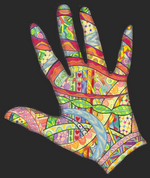
Patti- Posts : 3912
Join date : 2010-07-24
 Re: X - WALT DISNEY - One of his fingerprints shows an unusual characteristic!
Re: X - WALT DISNEY - One of his fingerprints shows an unusual characteristic!
Lynn wrote:Martijn (admin) wrote:
Sorry Lynn, you now sound like you 'firmly' claim that the Disney print is a 'tented arch'... but I see no evidence for that at all:
Instead of "Because the central ridge does not reach the shoulders", I should have said what I previously said - "IF the central ridge..." (because I now see the difficulty in exactly locating the shoulder line, I can't be sure.)Martijn (admin) wrote: Why do you think that the 'shoulder core' would result in 'no ridge count' at all?uh-oh, I made a mistake here!! - yes I can see a ridge count of 1.


Please take a look at fig. 186 below.

"The Science of Fingerprints"
"Figures 186 and 187 are tented arches of the same type. A close examination of these prints will reveal that when the imaginary line is drawn between delta and core no ridge count across a looping ridge can be obtained. It must be remembered that the core of a loop may not be placed below the shoulder line. Lacking one of the three characteristics of a loop, these patterns must be classified as tented arches."
Can you explain to me why fig. 186 isn't a loop and is classified a tented arch. Why do you see a ridge count of 1 in the similarly located core and delta of the Disney print?
I can see this is confusing as I spent some time last night searching the book for examples of 1 ridge count loops. There is a very fine line between the 1 ridge count loop and a tented arch. Very fine. (I bet they call it a shoulder line

Patti- Posts : 3912
Join date : 2010-07-24
 Re: X - WALT DISNEY - One of his fingerprints shows an unusual characteristic!
Re: X - WALT DISNEY - One of his fingerprints shows an unusual characteristic!
Patti wrote:
Please take a look at fig. 186 below.
Can you explain to me why fig. 186 isn't a loop and is classified a tented arch. Why do you see a ridge count of 1 in the similarly located core and delta of the Disney print?
In Fig 186 I think the core would be at the tip of the innermost recurve. A line drawn from delta to core would not cross any ridges, so no ridge count.
With Disney's if the core is placed on the shoulder furthest from the delta (or if it is placed at the tip of the central single ridge), we have the other side of the loop in between the delta & core i.e. a single ridge count.
 Re: X - WALT DISNEY - One of his fingerprints shows an unusual characteristic!
Re: X - WALT DISNEY - One of his fingerprints shows an unusual characteristic!
Patti wrote:Well Martijn, since only loops have cores and we only need to concern ourselves with cores when working with loops; I never placed the core.
I have always worked with the *core* you positioned.
apologies Patti, I made another mistake. I said...
Lynn wrote:I think we both already said: Because the central ridge does not reach the shoulders, the core should be at the shoulder furthest from the delta. If we place the core there, then there is no ridge count to class the print as a loop and it becomes a tented arch.Martijn (admin) wrote:maybe it would be helpful if you simply both describe where each of you think that we should put the 'core'.
sorry for saying "I think we both already said".
I corrected myself earlier, instead of "Because the central ridge..." I should have said "IF it is a loop and IF the central ridge does not reach the shoulders, then we would place the core at the shoulder furthest from the delta.
Of course I recognise that Patti has always seen this print as a tented arch.
 Re: X - WALT DISNEY - One of his fingerprints shows an unusual characteristic!
Re: X - WALT DISNEY - One of his fingerprints shows an unusual characteristic!
Lynn wrote:Patti wrote:
Please take a look at fig. 186 below.
Can you explain to me why fig. 186 isn't a loop and is classified a tented arch. Why do you see a ridge count of 1 in the similarly located core and delta of the Disney print?
In Fig 186 I think the core would be at the tip of the innermost recurve. A line drawn from delta to core would not cross any ridges, so no ridge count.
With Disney's if the core is placed on the shoulder furthest from the delta (or if it is placed at the tip of the central single ridge), we have the other side of the loop in between the delta & core i.e. a single ridge count.
Exactly. Lynn, I can confirm your explanation!

PS. Page 14 mentions that figure 139 is a likewise example: for the same reason both figure 186 and 139 are examples of a 'tented arch'.
What makes the Disney print different?
First of all: figure 186 and 139 do not have an 'inner ridge line', and secondly: the 'looping ridge line' is directed towards the 'triradius'... therefore the Disney print has hardly any similarities any of both of these examples.
Technically, the major difference regarding the pattern assessment is that figures 186 and 139 both do not have 'ridge count', while the Disney print has a 'ridge count' = 1 (maybe even 'ridge count' = 2 when the issue of the 'shoulders' is considered as significant well, but I think that my 'shoulder line' indicates that the issue of the 'shoulders' is not significant for the Disney print.... because that issue should only become decisive if there was clear evidence - like in figure 187 is seen - that the 'inner ridge line' does not reach the 'shoulder line').
 Re: X - WALT DISNEY - One of his fingerprints shows an unusual characteristic!
Re: X - WALT DISNEY - One of his fingerprints shows an unusual characteristic!
So you are saying the core is at the tip and there are no shoulders? What if you imagine a rod that was below the shoulders in this sample and the core is placed on the far shoulder - where would you place it?
Some of us have continued to use triradius in this conversation, but it became apparent that in the FBI's "The Science of Fingerprints" they refer to the point that is measured to the core as the "delta".
This is because in a loop pattern, you need to draw your type lines. Lines that start out parallel on one side and then part ways. One goes around the top of the pattern and the other is across the bottom. They create an outline of the center pattern, with the pattern contained within.
Once you find the type lines, then there are rules to find the delta. It is not always a shape that could be called a triradius. It can be a point on a ridge. When I drew the coordinates using all 4 prints, I also explained to Martijn I was not lining up the prints to cores or deltas but matching features.
The line determining ridge count is drawn between the delta and the core without counting the delta and the core in the count.
Therefore, it's important that we go through each of these focal points and see if we can find some common ground.
As a firm believer it's a tented arch, I'll prepare my presentation for type lines for a tented arch. Perhaps Martijn, you can present something regarding type lines for this as a loop. Lynn you can then tell us how you'd adjust the lines in both unless you can add your own illustration.
(Martijn, one of the objections I have to your banana dot coordinates, is that on some ridges you chose to lean inwards on the line and sometimes you seemed to lean outwards - following a path that left us with a visual effect you wished us to have. Please try to stay in the middle of the ridge lines - as that is more likely areas not so affected by pixelation and ink issues.)
We need to find these:
a) Type Lines
b) Delta
c) Core
d) Shoulders
We need to understand these:
1) Spike
2) Rod
3) Upthrust
4) Ending Ridge Line
and
Shoulders plus Shoulder Line


Patti- Posts : 3912
Join date : 2010-07-24
 Re: X - WALT DISNEY - One of his fingerprints shows an unusual characteristic!
Re: X - WALT DISNEY - One of his fingerprints shows an unusual characteristic!
Martijn (admin) wrote:Oh my God....Patti wrote:
The pink arrow indicates where the points on each shoulder would cross.
The green arrow shows the highest level reached by the core.
The core is below the shoulders.
End of this never ending story....?... Patti, I am shocked to see the new 'pink arrows' in your picture. My appologies, I had completely misunderstood your 'horizontal green lines'!
However,... your 'pink arrows' helped me to finally also completely understand the nature of mistake regarding 'your quote' from page 41:
Because after seeing your true 'shoulder lines' now I recognize how 'your argument' could actually be applied to far most fingerprints that have a central 'single ridge line'...!!!Patti, you missed the overruling guideline for the 'core', as described on page 14:
"The core, as the name implies, is the approximate center of the finger impression. It will be necessary to concern ourselves with the core of the loop type only. The following rules govern the selection of the core of a loop:
...."
The words 'core of the loop type' clearly ONLY relates to the central ridge line(s) that could be used for identifying the core... not the overall fingerprint assessment, because that assessment is only possible after the identification of the 'core'.
EDIT: And of course... it is important to notice as well that the 4 guidelines ONLY relate to fingerprints where any variant of 'core of the loop type' is seen (which explains why the 2nd, 3th and 4rd guidelines start with the words: "When the innermost sufficient recurve contains....").
But in the Disney fingerprint we are NOT confronted with any 'core of the loop type' at all... simply because: there is the 'single ridge line'!!!!
Patti, this clearly shows AGAIN... that you completely misinterpretated 'your quote' taken from page 41, because - exactly like I described - the larger context of those words about the 'shoulder line' clearly shows that the 'shoulder line' was only mentioned in the perspective of figures 186 + 187... which both have a 'core of the loop type'.
But Disney's fingerprint does not have a 'core of the loop type' at all! That is why 'your quote' from page 41... is completely irrelevant for our assessment for Disney's fingerprint!!!










































EDIT: A few posts later I had to admit that I made a mistake regarding the words 'core of the loop type', so my 'cheers' could be perceived as inappropriate.
But I can also add that my major point regarding the insignificance of the 41 quote turned out to be correct... because even when the criteria regarding the 'shoulder line' are applied to Disney's fingerprint it is not clear at all that the 'core' would change position. And even when the 'core's' position would shift to the 'right shoulder' of the 'looping ridge line'... a 'ridge count' is still observed (the ridge count then becomes 1 or 2). At least, Lynn & I agree about this issue.
So, at the end the quote at page 41 indeed turned out to be irrelevant - but my argument regarding the words 'core of the loop type'... turned out to be even more irrelevant!! My apologies for making that suggestion.
Thank you Martijn. I just noticed your acknowledgement of your little egg on your face mistake, and that you now realize that your whole argument is that Disney's print does concern a "core of the loop type".

Before you get too get excited. You haven't firmly established a ridge count yet, as you have yet to establish the shoulder line, the accurate location of the core, and then the delta (via establishing type lines). Then once that is done, a ridge count can be obtained.

Patti- Posts : 3912
Join date : 2010-07-24
 Re: X - WALT DISNEY - One of his fingerprints shows an unusual characteristic!
Re: X - WALT DISNEY - One of his fingerprints shows an unusual characteristic!
Patti wrote:...
Before you get too get excited. You haven't firmly established a ridge count yet, as you have yet to establish the shoulder line, the accurate location of the core, and then the delta (via establishing type lines). Then once that is done, a ridge count can be obtained.
Hi Patti,
No problem at all, here we go...
First I demonstrated where in the picture the 'looping ridge line' is found:

Then I demonstrated how the 'central ridge line' reaches the 'shoulder line':
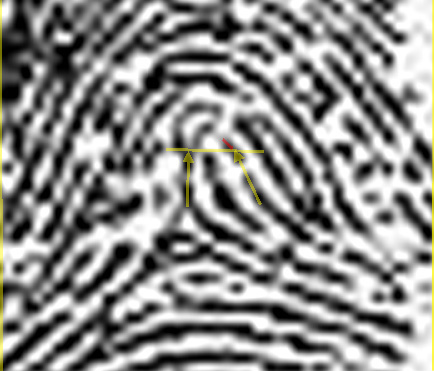
And now... after combining both pictures... and after adding the 'core' (C) and the 'triradius' (D = DELTA)... it becomes quite easy to see where in this fingerprint the 'ridge count = 1' is found:
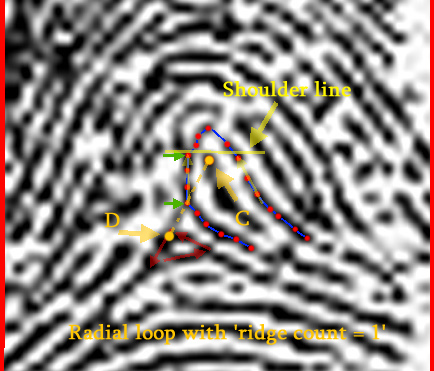
NOTICE:
Patti, the following notificiations explain the elements seen in the picture:
1 - Regarding the position of the 'triradius' [= DELTA], figures 33 and 39 in the F.B.I. book helped me to recognize that formally the 'DELTA' should be positioned at point D.
2 - And then we can see how the 'ridge count = 1' results from the point where the dotted-line between the 'core' (C) [= the highest point of the 'central ridge line'] and the 'delta' (D) passes the 'looping ridge line' [= the innermost sufficient recurve].
 Re: X - WALT DISNEY - One of his fingerprints shows an unusual characteristic!
Re: X - WALT DISNEY - One of his fingerprints shows an unusual characteristic!
Martijn (admin) wrote:Patti wrote:...
Before you get too get excited. You haven't firmly established a ridge count yet, as you have yet to establish the shoulder line, the accurate location of the core, and then the delta (via establishing type lines). Then once that is done, a ridge count can be obtained.
Hi Patti,
No problem at all, here we go...
First I demonstrated where in the picture the 'looping ridge line' is found:
Then I demonstrated how the 'central ridge line' reaches the 'shoulder line':
And now... after combining both pictures... and after adding the 'core' (C) and the 'triradius' (D = DELTA)... it becomes quite easy to see where in this fingerprint the 'ridge count = 1' is found:
NOTICE:
Patti, the following notificiations explain the elements seen in the picture:
1 - Regarding the position of the 'triradius' [= DELTA], figures 33 and 39 in the F.B.I. book helped me to recognize that formally the 'DELTA' should be positioned at point D.
2 - And then we can see how the 'ridge count = 1' results from the point where the dotted-line between the 'core' (C) [= the highest point of the 'central ridge line'] and the 'delta' (D) passes the 'looping ridge line' [= the innermost sufficient recurve].
Thank you Martijn.
1)
In your second image, if we considered the rules of a rod that continues up to the recurve that location is where the core is placed. As well as in the illustration earlier, the core was placed in the center of the recurve. This would indicate that we should consider the direction the core is going in. Obviously that focus point would be to the area with the noticible angle or tightest curve. This is where the *loop* recurves and heads in the opposite direction.
You have placed the shoulder in a major uneven proportion on the right side as to the left side. I didn't see any such pronounced slanting of the shoulder line in the examples.
If we were to all agree on the left shoulder location (on all three prints) then it would appear that the obvious place to put the right shoulder is where you put the first red dot from the top heading down on the right (3rd image). When the sides are obviously running in opposite directions, or appear nearly parallel, we are no longer in the recurve. The ends and boundaries of the recurve is the shoulder line.
2)
In your bottom image, did you check the rules to see if you can put the Delta where you placed it?
Where are your type lines? Here's a clue. In order for that to be a valid loop, the litte red arrow pointing WNW has to be sitting on the type line. It's on the next ridge outside the "loop pattern" you are proving to be contained within.
You also need to start with two parallel lines that diverge. Then after tracing them you can legitimately point out the delta.


Patti- Posts : 3912
Join date : 2010-07-24
 Re: X - WALT DISNEY - One of his fingerprints shows an unusual characteristic!
Re: X - WALT DISNEY - One of his fingerprints shows an unusual characteristic!
The purple dot is where I would see the delta. It's the first location after two parallel lines diverge. Delta is located on the only recurving ridge.
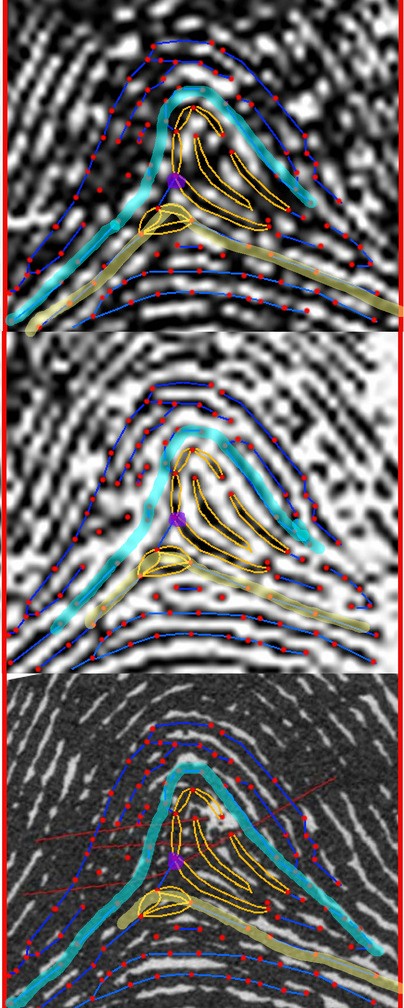

Patti- Posts : 3912
Join date : 2010-07-24
 Re: X - WALT DISNEY - One of his fingerprints shows an unusual characteristic!
Re: X - WALT DISNEY - One of his fingerprints shows an unusual characteristic!
Patti wrote:
Thank you Martijn.
1)
In your second image, if we considered the rules of a rod that continues up to the recurve that location is where the core is placed. As well as in the illustration earlier, the core was placed in the center of the recurve. This would indicate that we should consider the direction the core is going in. Obviously that focus point would be to the area with the noticible angle or tightest curve. This is where the *loop* recurves and heads in the opposite direction.
You have placed the shoulder in a major uneven proportion on the right side as to the left side. I didn't see any such pronounced slanting of the shoulder line in the examples.
If we were to all agree on the left shoulder location (on all three prints) then it would appear that the obvious place to put the right shoulder is where you put the first red dot from the top heading down on the right (3rd image). When the sides are obviously running in opposite directions, or appear nearly parallel, we are no longer in the recurve. The ends and boundaries of the recurve is the shoulder line.
2)
In your bottom image, did you check the rules to see if you can put the Delta where you placed it?
Where are your type lines? Here's a clue. In order for that to be a valid loop, the litte red arrow pointing WNW has to be sitting on the type line. It's on the next ridge outside the "loop pattern" you are proving to be contained within.
You also need to start with two parallel lines that diverge. Then after tracing them you can legitimately point out the delta.
Patti, thanks for your specified comments & questions:
Ad 1) FIRST ALINEA: I don't understand your comment about the 'rod', because you are actually talking about a 'rod that continues up to the recurve', and we do not find that situation in the Disney print.
SECOND + THIRD ALINEA: No, I think there is no 'objective' need to adjust the 'right shoulder'; regarding the point that you suggested: the right 'red arrow' clearly indicates that at the point the ridge line is already turning INWARDS. Both 'red arrows' are pointing towards the highest point of the recurve, which indicates that my 'shoulder line' does meet the criterium described at page 14 for the 'shoulders':
"The shoulders of a loop are the points at which the recurving ridge line definitely turns inward or curves"
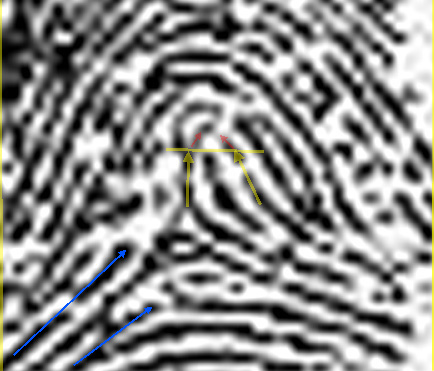
Ad 2) Yes, I found the triradius with the rules described at page 12 (see e.g. the 3th point regarding a series of bifurications). Again, figures 33 + 39 are also helpful because both include elements that we also see in Disney's fingerprint..
Regarding the 'type lines', I have illustrated the starting points of the 'type lines' with the blue arrows.
PS. Your comment regarding the 'red arrow' is not correct, because the 'red arrow' is ON the single 'looping ridge line', while the 'type lines' are found OUTSIDE the 'pattern area' - in a loop the 'pattern area' concerns e.g. the looping ridges:
Page 7 presents the definition of the 'type lines':
"Type lines may be defined as the two innermost ridges which start parallel, diverge, and surround or tend to surround the pattern area."
Page 8 describes:
"Type lines are not always two continuous ridges. In fact, they are more often found to be broken."
(In the Disney print they are broken, the blue arrows clearly show where they start... and there is no need/requirement to identify the other parts of the 'type lines')
Last edited by Martijn (admin) on Sat Mar 05, 2011 1:50 am; edited 2 times in total
 Re: X - WALT DISNEY - One of his fingerprints shows an unusual characteristic!
Re: X - WALT DISNEY - One of his fingerprints shows an unusual characteristic!
Patti wrote:I realized Martijn that you had already outlined with blue lines and red dots the ridges on each side of the pattern, making it easy to see the ridges you earlier identified as Type Lines.
The purple dot is where I would see the delta. It's the first location after two parallel lines diverge. Delta is located on the only recurving ridge.


Sorry Patti, your suggestion that the 'purple dot' could be recognized as the 'delta' is incorrect, because this violates the FIRST rule for the 'delta' (see page 12):
"# The delta may not be located at a bifurication which does not open toward the core."
(Every 'bifurcation' always OPENS at the side where the smallest angle is found!)
The picture below clearly shows that the 'bifurcation' at the lowest green point is directed DOWNWARD:

Remember, earlier in this discussion I already considered that point, and mentioned that it indeed can be recognized as 'bifurcation' with an angle smaller than 90 degrees between the two downward pointing ridge lines (see the green pointer picture above). So that bifurcation is clearly pointing DOWNWARD, and therefore we can safely conclude that the bifurcation at your 'purple dot' is not directed toward the 'core'!
EDIT: And for the same reason the 'bifurcation' at the upper green pointer can not be the 'delta' (though at the point the 'bifurcation' is pointed UPWARD).
PS. And as a result of this mistake, you also incorrectly identified the YELLOW LINE as one of the type lines. In the picture in my former post you see that the true 'delta' in Disney's fingerprint is actually found ON that YELLOW LINE.
 Re: X - WALT DISNEY - One of his fingerprints shows an unusual characteristic!
Re: X - WALT DISNEY - One of his fingerprints shows an unusual characteristic!
Patti, the post before my last post included a technical mistake... I initially presented a picture without the BLUE ARROWS, but now the arrows are visible!
Please confirm that you noticed this correction, then I will deleted this post
 Re: X - WALT DISNEY - One of his fingerprints shows an unusual characteristic!
Re: X - WALT DISNEY - One of his fingerprints shows an unusual characteristic!
Two parallel lines that diverge.
They should not have ridge line between them.
Even if they are parallel a short distance and diverge they are counted. That is clearer in the 1933 print.
Have you noticed Martijn, how many times that an inconvenient rule pops up, you immediately tell us it is unimportant or insignificant. That is what I call 'smoke and mirrors'. You tell us to see what you want us to see and tell us not to notice what you don't want us to notice.
I think you correctly placed the lines in blue with red dots earlier when you didn't realize that they were important. You just followed what you saw.
The only place the delta can go after the two line I traced part ways is the next ridge in. You had called the areas outside your bananas ink blots. Are you now seeing them as ridge lines?

Patti- Posts : 3912
Join date : 2010-07-24
 Re: X - WALT DISNEY - One of his fingerprints shows an unusual characteristic!
Re: X - WALT DISNEY - One of his fingerprints shows an unusual characteristic!
Martijn (admin) wrote:Patti wrote:
Thank you Martijn.
1)
In your second image, if we considered the rules of a rod that continues up to the recurve that location is where the core is placed. As well as in the illustration earlier, the core was placed in the center of the recurve. This would indicate that we should consider the direction the core is going in. Obviously that focus point would be to the area with the noticible angle or tightest curve. This is where the *loop* recurves and heads in the opposite direction.
You have placed the shoulder in a major uneven proportion on the right side as to the left side. I didn't see any such pronounced slanting of the shoulder line in the examples.
If we were to all agree on the left shoulder location (on all three prints) then it would appear that the obvious place to put the right shoulder is where you put the first red dot from the top heading down on the right (3rd image). When the sides are obviously running in opposite directions, or appear nearly parallel, we are no longer in the recurve. The ends and boundaries of the recurve is the shoulder line.
2)
In your bottom image, did you check the rules to see if you can put the Delta where you placed it?
Where are your type lines? Here's a clue. In order for that to be a valid loop, the litte red arrow pointing WNW has to be sitting on the type line. It's on the next ridge outside the "loop pattern" you are proving to be contained within.
You also need to start with two parallel lines that diverge. Then after tracing them you can legitimately point out the delta.
Patti, thanks for your specified comments & questions:
Ad 1) FIRST ALINEA: I don't understand your comment about the 'rod', because you are actually talking about a 'rod that continues up to the recurve', and we do not find that situation in the Disney print.
SECOND + THIRD ALINEA: No, I think there is no 'objective' need to adjust the 'right shoulder'; regarding the point that you suggested: the right 'red arrow' clearly indicates that at the point the ridge line is already turning INWARDS. Both 'red arrows' are pointing towards the highest point of the recurve, which indicates that my 'shoulder line' does meet the criterium described at page 14 for the 'shoulders':
"The shoulders of a loop are the points at which the recurving ridge line definitely turns inward or curves"
Ad 2) Yes, I found the triradius with the rules described at page 12 (see e.g. the 3th point regarding a series of bifurications). Again, figures 33 + 39 are also helpful because both include elements that we also see in Disney's fingerprint..
Regarding the 'type lines', I have illustrated the starting points of the 'type lines' with the blue arrows.
PS. Your comment regarding the 'red arrow' is not correct, because the 'red arrow' is ON the single 'looping ridge line', while the 'type lines' are found OUTSIDE the 'pattern area' - in a loop the 'pattern area' concerns e.g. the looping ridges:
Page 7 presents the definition of the 'type lines':
"Type lines may be defined as the two innermost ridges which start parallel, diverge, and surround or tend to surround the pattern area."
Page 8 describes:
"Type lines are not always two continuous ridges. In fact, they are more often found to be broken."
(In the Disney print they are broken, the blue arrows clearly show where they start... and there is no need/requirement to identify the other parts of the 'type lines')
1) I was using the example of 186 and locating the core at the very top of the recurve as an example for where the center should be between the shoulders of Disney's print. That why I wanted you to visualize it with a rod.
I think if you look at the area that is the "recurve" the area that is not up or down (or side) but is "over the top" then you can see that the "space between the shoulders" is very narrow.
That is why you must look at where core is placed in all examples in the book. None are as far down the side as you are placing yours. None have such a slant. It is obvious that you want the right shoulder to be lower.
Look up the description for the area called the *recurve* "the space between the shoulders"!
Your top blue arrow is correct, your bottom blue arrow is incorrect.
These are very important details to decide upon or you will not be able to prove you have an unspoiled loop.
Why not use all three prints to make your point?
I was refering to your red arrow, you drew three around the 3 bananas that made a triangle. According to your previously drawn type lines, you would need to use the top two bananas. They are not part of the pattern.
And you last line ""Type lines are not always two continuous ridges. In fact, they are more often found to be broken."
(In the Disney print they are broken, the blue arrows clearly show where they start... and there is no need/requirement to identify the other parts of the 'type lines')
is absolutely nonsense. Did you forget the rules from when we were drawing our a, b, c, and d lines in the palms and a ridge ending?
So yes, there is a need.
You cannot place the delta until you have identified the type lines. Yes there are rules for bifurrcations. Let's look at those when we need to. So far you haven't drawn one that interfers with the innermost type lines. You cannot skip the ridge that is immediately out side the pattern. Especially if the beginning of the ridge line was parallel, even for a short distance, to the other type line. I think the lines I colored in your example of the 1933 print is the most accurate that can be drawn around a loop center... if it's a loop.

Patti- Posts : 3912
Join date : 2010-07-24
 Re: X - WALT DISNEY - One of his fingerprints shows an unusual characteristic!
Re: X - WALT DISNEY - One of his fingerprints shows an unusual characteristic!
Martijn, Excuse me.
Do you know what the recurve is? You don't find it by running up the side to see when the side curves inward.
You find the "recurve" area first. The recurve is another designation. This time it is a span. It is the official space known as "between the shoulders". The shoulders are where you put little x's and then draw the Shoulder line across.
You do NOT find the recurve by running up the side of a loop.
This is why I had you both look at 186 when choosing the core. Obviously they go midway between the shoulders.
<edit> actually you could find the recurve by running up the side of the loop, but you don't stop when IT starts to curve or move inward. You have to rise up one side, go over the top, and down the other side. The "over the top" is the recurve area. You're either on the top or you are on one of the sides. The shoulder is the spot where the recurve ends and the side begins. The side does not count when talking about spikes and short abutting ridges only the space between the shoulders.
Since there are spikes and short abutting ridges on the outside of the possibly recurving ridge, this area is of great importance to whether this is a tented arch or a loop.

Patti- Posts : 3912
Join date : 2010-07-24
 Re: X - WALT DISNEY - One of his fingerprints shows an unusual characteristic!
Re: X - WALT DISNEY - One of his fingerprints shows an unusual characteristic!
Does this make sense yet?

Patti- Posts : 3912
Join date : 2010-07-24
 Re: X - WALT DISNEY - One of his fingerprints shows an unusual characteristic!
Re: X - WALT DISNEY - One of his fingerprints shows an unusual characteristic!
Seems like one more rule in the combination of rules that help people not confuse a tented arch with a loop.
Upthrust
Angles
Short Rods
Difficult to find ridge count between delta and core - or no ridge count
spikes & short ridges on outside of recurve
did I miss any?

Patti- Posts : 3912
Join date : 2010-07-24
 Re: X - WALT DISNEY - One of his fingerprints shows an unusual characteristic!
Re: X - WALT DISNEY - One of his fingerprints shows an unusual characteristic!
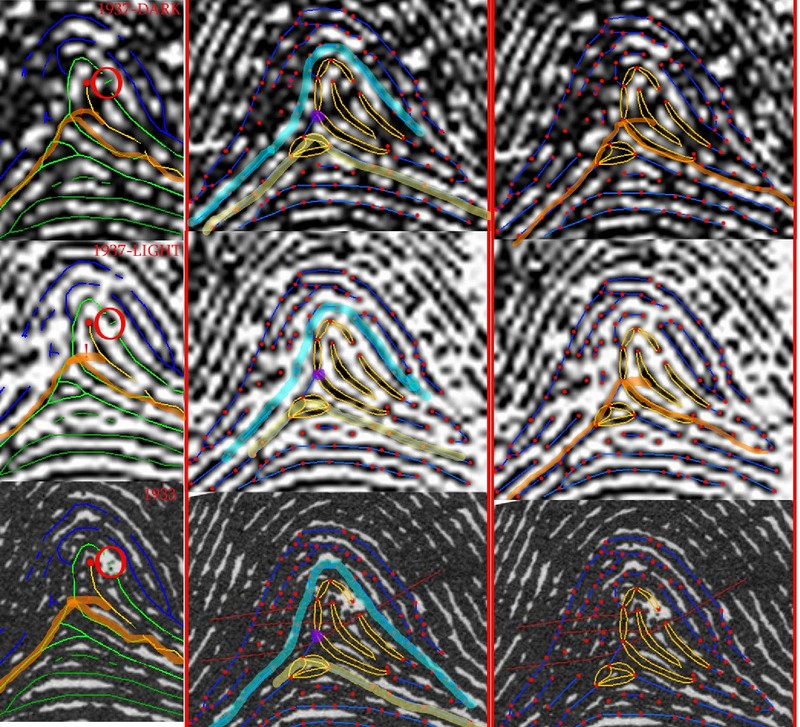
Martijn, you have made a good point when you quote "The delta may not be located at a bifurcation which does not open toward the core."
This forces us to look at that marking that is apparent in the dark 1937 print, the 1933 print but missing in the light 1937 print. (where you placed the question "?" mark)
There is either a bifurcation or it's an abutment.
Look at the lines I drew in orange. I know they are not perfect but they follow the ridges pretty closely.
How would you draw these ridges differently?
There are definitely horizontal ridges and there are vertical ridges.
They cannot cross. We've already agreed on that. In order to see a loop, we must pretend we are not seeing the horizontal bars between the rod and left side of the possible recurving ridge.
We've been looking at the ridges in the perspective you have asked to look at them so that we may see a loop. This is that we see the horizontal ridges as "not there", extra ink, or abutting as they move horizontally.
When we try to make a loop with that in mind we are confronted with many issues. Issues as to where and how to draw the type lines. You claim too many broken lines. Issues as to where are the shoulders, where is the recurve, where is the core and where is the delta. So many questions and issues to solve.
Along with that is the need to not see ink in some places and to imagine ink in others.
I think we really should take a different perspective and instead of continuing to look at those horizontal ridges as the abutting ridges, but to look at the vertical ridges as abutting against the horizontal ridges.
See next image.
Last edited by Patti on Sat Mar 05, 2011 5:58 am; edited 1 time in total

Patti- Posts : 3912
Join date : 2010-07-24
 Re: X - WALT DISNEY - One of his fingerprints shows an unusual characteristic!
Re: X - WALT DISNEY - One of his fingerprints shows an unusual characteristic!
a Tented Arch.
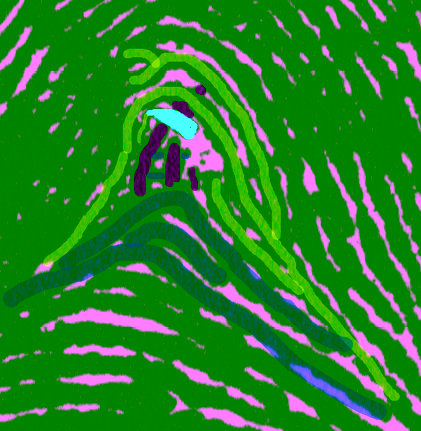

Patti- Posts : 3912
Join date : 2010-07-24
 Re: X - WALT DISNEY - One of his fingerprints shows an unusual characteristic!
Re: X - WALT DISNEY - One of his fingerprints shows an unusual characteristic!
Patti's last drawing on 1933 print makes a convicing tented arch!
 Re: X - WALT DISNEY - One of his fingerprints shows an unusual characteristic!
Re: X - WALT DISNEY - One of his fingerprints shows an unusual characteristic!
Patti wrote:I can see at a glance that you are making big, big errors (in your favor, of course).
Two parallel lines that diverge.
They should not have ridge line between them.
Even if they are parallel a short distance and diverge they are counted. That is clearer in the 1933 print.
Have you noticed Martijn, how many times that an inconvenient rule pops up, you immediately tell us it is unimportant or insignificant. That is what I call 'smoke and mirrors'. You tell us to see what you want us to see and tell us not to notice what you don't want us to notice.
I think you correctly placed the lines in blue with red dots earlier when you didn't realize that they were important. You just followed what you saw.
The only place the delta can go after the two line I traced part ways is the next ridge in. You had called the areas outside your bananas ink blots. Are you now seeing them as ridge lines?
Patti, I assume that your first 4 comments relate to the 'type lines'?
The 'type lines' definition on page 7 says:
"Type lines may be defined as the two innermost ridges which start parallel, diverge, and surround or tent to surround the pattern area."
Patti, first of all: you describe that the 'type lines' are required... quoted from your words: "...should not have ridge line between them."
But where did you find such a requirement? Figure 27 & figure 30 clearly show that the types (T and T) can have a ridge between them. So, the requirement that you described... does not exist at all!

Second, if you would have looked at my 'blue lines' closely... then you should have noticed that my blue lines do diverge!

 Third, yes ... after looking closely at figure 28 in the F.B.I. book, I can see that I did made a mistake as well:
Third, yes ... after looking closely at figure 28 in the F.B.I. book, I can see that I did made a mistake as well:Despite that I had to point out that you created yourself a 'new rule' (which doesn't exist at all!), and you made an incorrect observation regarding my 'blue lines' (they do diverge!),... yes, I must admit that I did make a mistake here... because I should have drawn the lower type line at another ridge line, see the picture below!

 ... During this discussion my drawings have shown a high level of consistancy, and with the help of your feedback & Lynn's feedback my pictures kept improving:
... During this discussion my drawings have shown a high level of consistancy, and with the help of your feedback & Lynn's feedback my pictures kept improving: I have now also hightlightened the 'top' of the recurve with the same 'red dot' that I used earlier in my pictures, and I have also slightly lifted the right sight of the 'shoulder' - following the suggestion made by Lynn.
Resulting in that we can now clearly see that 'my shoulders' are not only following the rule that they are found at the point where the "recurving ridge definitely turns inwards or curves", we can also see that both sides also show is a high level of SYMMETRY in the perspective of the 'top'!
Finally, regarding your last point related to the delta... I am not sure what you are trying to say there. But I now would like to describe explictely why the DELTA is found at the location which I described in my former post (see the picture above):
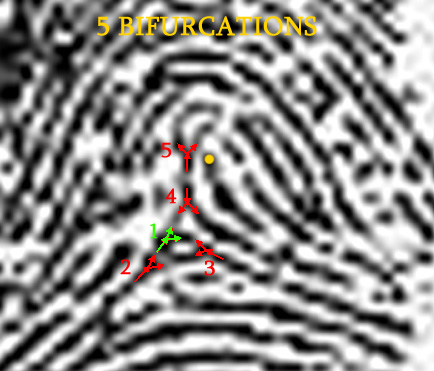
First of all, the picture below clearly shows why we are faced with the problem of identifying the position of the DELTA... because there is no clear 'triradius' seen in this print... however, there are 5 'bifurcations' that could be associated with the delta - but after the following two considerations if becomes very obvious why only 'bifurcation 1' can be described as the delta!
But only 'bifurcation 1' and 'bifurcation 2' meet the first criterium for the DELTA desribed at page 12 of the book (I quote again):
"# The delta may not be located at a bifurcation which does not open toward the core."
'Bifurcation 3, 4 and 5' do not meet this criterium - so we only need to consider the other two!
And because 'bifurcation 1' and 'bifurcation 2' can be recognized as a SERIES OF BIFURCATIONS, we can apply the third rule described at page 12 of the book:
"# When there is a series of bifurcations opening toward the core at the point of divergence of the two type lines, the bifurcation nearest the core is chosen as the delta."
Therefore I am 100% sure that 'bifurcation 1' can only be described as the DELTA!
Patti, I hope you now recognize that my mistake regarding the lower 'type line' has no implications for my assessment that in the Disney print we can CLEARLY identify the 3 essential requirements for a loop (quoted from page 18 in the F.B.I. book):
- A sufficient recurve
- A delta
- A ridge count across a looping ridge.
The picture below shows all essential elements, which clearly indicate that the Disney print is ... a RADIAL LOOP:

The original print might be helpful as a point of reference:
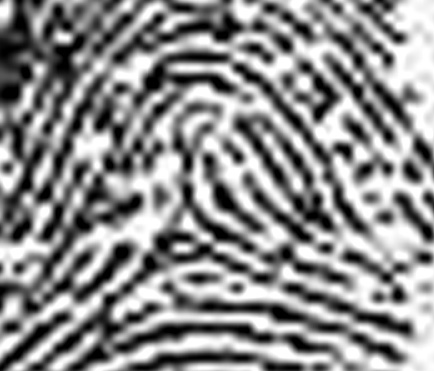
PS. Patti, I also would like to add the following thought:
In my first attempt I hardly explained my 'type lines'... so your accusation regarding that I am fouling-around-with-the-rules (my words) is unfounded... let's be reasonable: if I make a mistake you should not translate that into that I am trying to change the rules. Especially, when the mistake has no consequences regarding my assessment at all!
And I do not recognize at all how my mistake was 'in my favour'... like you suggested!
And it is quite funny that while you make these unfounded accusations (for sure, I did not describe any incorrect rule regarding the 'type lines' because I in that post I only quoted from the book regarding the requirements)... you actually described YOURSELF an incorrect rule.
Patti we all make mistakes... but you should never ever make the assumption that I am making them 'with a purpose'. I can only hope that you will at least give it a thought about why you made these suggestions - because again... I mentioned this already quite a few times...
I never tried to 'trick' you anyhow!

Last edited by Martijn (admin) on Sat Mar 05, 2011 2:09 pm; edited 6 times in total (Reason for editing : Spelling, added: one sentence + the 4th picture as a point of reference.)
 Re: X - WALT DISNEY - One of his fingerprints shows an unusual characteristic!
Re: X - WALT DISNEY - One of his fingerprints shows an unusual characteristic!
Lynn wrote:Hi Martijn & Patti, I said I was going to back and read the bits I'd only glanced over (after missing the start of this discussion when on holiday) - bifurcations, spikes, white patches, ink blobs, spoiled recurves etc. But actually I have a lot of other, more urgent, things to do. Sorry I am leaving this discussion to you two for now!
Patti's last drawing on 1933 print makes a convicing tented arch!
Okay Lynn, I think we can all can understand that you have other priorities. But can I make a final request? Would you mind to at least read my last post, and share your thought?
(I describe in that post why I have positioned the DELTA + the CORE at the locations in that I have described from the start of this discussion, and in my last picture - which I consider as by far the best picture that I have produced so far - I have e.g. honoured your suggestion to put the the RIGHT SHOULDER at a 'slightly higher' location!)

 Re: X - WALT DISNEY - One of his fingerprints shows an unusual characteristic!
Re: X - WALT DISNEY - One of his fingerprints shows an unusual characteristic!
Patti wrote:And another thought. If you see both your arrows as pointing upward to the highest point on the recurve, then obviously the shoulders are even higher. As you shouldn't be looking up still. When you get to the shoulder, you should be looking *over*.
Does this make sense yet?
Sorry Patti, your thought does not makes sense to me.
Let me explain this by adding the following three observations:
- First of all, we should notice that the problem of identifying the 'shoulder line' is a result of the fact that the Disney prints confronts us with an ASYMMETRICAL pattern area.... which probably explains partly why we are discussing this issue.
- Second, in my new picture (after putting the right shoulder a little higher as suggested by Lynn) you can see that the yellow arrows are not pointing to the highest point, which implicates that in that zone the ridge lines are not yet 'turning inward'. This explains how I used THE PATH OF THE RIDGE LINES to identify the 'shoulder line'.
- Third, at the location of the red arrows we can see the ridge lines clearly turning towards the 'top' of the recurve. So, the 'shoulder line' it is common sense to assume that the 'shoulder line' requires to be positioned BELOW the red arrows.
This explains why the 'shoulder line' should be located very close to where I have positioned it in the picture below (which I also presented in my former longer post).

 Re: X - WALT DISNEY - One of his fingerprints shows an unusual characteristic!
Re: X - WALT DISNEY - One of his fingerprints shows an unusual characteristic!
Sorry Patti, I see no basis for making that association at all.Patti wrote:It's starting to look like the location of the delta may ruin the ridge count.
...
Because in figure 33 in the book clearly shows that the position of the upward turning line from the DELTA is allowed to 'cross' the VIRTUAL LINE between the 'core' and the DELTA.
PS. One more thought regarding another example in advance:
We should not consider figure 34 as relevant for the Disney print, because in figure 34 we can see that the 'bifurcation' that could be associated with the DELTA actually violates the first rule for the DELTA (as described in the book on page 12 in the book): because the 'bifurcation' does not open towards the core.
This explains why in that example the DELTA is positioned at the endpoint of the right downward pointing ridge line.
Page 13 of 26 •  1 ... 8 ... 12, 13, 14 ... 19 ... 26
1 ... 8 ... 12, 13, 14 ... 19 ... 26 
 Similar topics
Similar topics» SCHIZOPHRENIA - The language of the hands!
» Robin Williams: hands of a crazy comic genius!
» The 'HOCKEY-STICK' CREASE - A characteristic in CHARGE- & fetal alcohol syndrome
» FINGER LENGTH SHOWS: Neanderthals were more competitive & promiscuous!
Modern Hand Reading Forum - Discover the language of your hands: palm reading & palmistry forum! :: VI - FAMOUS HANDS: PHOTOS, READINGS, QUESTIONS & DISCUSSIONS :: VIa - FAMOUS HANDS - The hands of celebrities, honourable individuals & remarkable people!










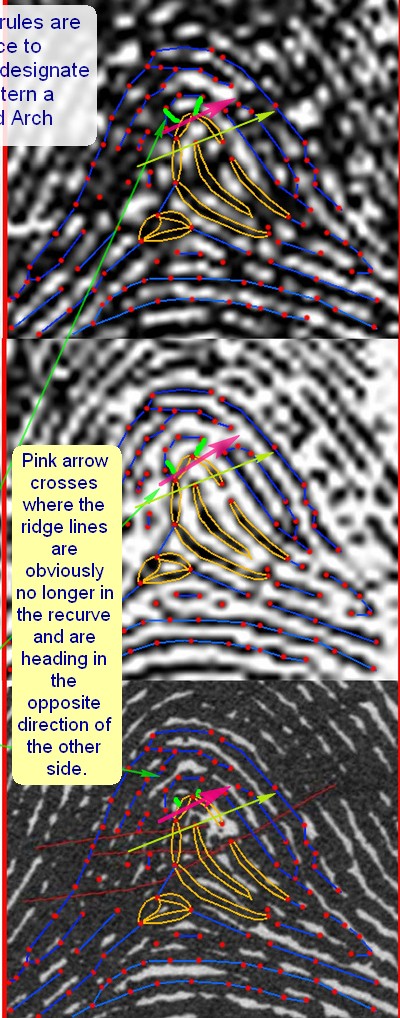
» Can anyone read it for me?
» Square on Marriage line
» Cross in mount Jupiter
» clinodactyly: top phalanges bending towards Mercury finger
» Can anybody please read this hand
» Nisha Ghai
» Absolutely non-sense career till now
» Fate Destiny Line -
» VIII - Palmistry books TOP 100 - listed by 'Amazon Sales Rank'!
» Stewart Culin - Palmistry in China and Japan
» Herbert Giles - Palmistry in China
» life line forks
» Astro-Palmistry files
» unique lines on Saturn mount